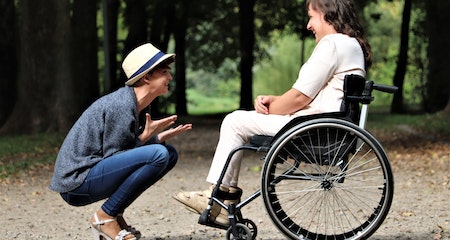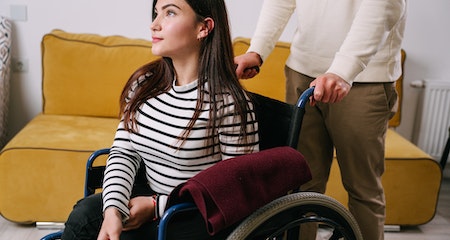When you are taking care of a disabled person, there are several important steps to take. To start, make sure the disabled person is safe. Keep a close watch on any potential dangers around the home and make sure that the house is a secure place. It is also important to remind the disabled person of their abilities and limits. Encourage them to carry out some tasks independently and encourage them to take regular breaks.
Adaptive equipment
Adaptive equipment is designed to make daily activities easier for people with disabilities. It helps them move about the house and do daily tasks such as bathing and eating. It also helps them stay safe. Two thirds of American adults age 65 and up need some assistance with daily activities. A wide range of daily living aids can help people with disabilities in these areas.
Adaptive equipment must meet certain standards before it can be sold. These standards are set forth in the Standard. It is the responsibility of the manufacturer or supplier to ensure that a product meets the highest safety, quality and usability standards. Vendors must also provide written documentation if they modify adaptive equipment.
Adaptive equipment must be made of durable materials. All hardware must conform to SAE standards. Fasteners must be grade 5 or higher and be treated to resist vibration. All mounting hardware must resist permanent deformation and failure of joints under normal use. In addition, the hardware should permit the able-bodied driver to operate the device.
Adaptive equipment is an important part of the daily living activities of a person with a disability. Adaptive equipment can help the disabled person move around the house and perform other activities of daily living. This equipment can help people with limited mobility with activities like bathing and eating.
Self-care
Self-care is an essential part of healthy living for people with a disability in Melbourne. It involves taking time to care for yourself, making sure your physical, emotional, and mental wellbeing is maintained. While it’s important for anyone to take care of their own health, self-care for disabled people may be especially difficult. People with disabilities often have to modify their lifestyle to make it easier to take care of themselves.
Often times, parents of children with disabilities experience high levels of chronic stress, anxiety, and depression. The challenges that parents face can be heartbreaking. Parents must work to ensure that their children have access to services and opportunities, while simultaneously caring for themselves. Self-care must be a priority for parents of disabled children.
While physical care is important, volunteering to help others is also an important form of self-care. Research by the University of Hong Kong shows that volunteering can increase a person’s self-esteem and reduce their symptoms of depression. Moreover, people with disabilities often feel more satisfied with their lives when they are able to do something to help others.
Self-care is essential for disabled people to stay healthy and active. Self-care activities can be anything that helps them maintain their health and independence. The National Institute on Disability and Rehabilitation Research and the CDC have conducted surveys to determine the level of self-care needs of people with disabilities. These data will help guide future public policies and programs to provide assistance to those with disabilities.
Nutrition
To combat hunger in the disabled community, the United States must make better use of data on the nutritional needs of disabled people. Lack of data about disabilities in food systems makes it difficult for the federal government to properly address these needs. The federal government should work with local community organizations to better understand disability-related issues. The government should also involve CIL programs and nutrition assistance administrators on the ground to improve nutrition for disabled people.
Disabilities often affect a child’s growth and development. They can cause a child to miss developmental milestones and develop secondary disabilities, and may even lead to premature death. Some disabilities, such as cerebral palsy, result in undernutrition in children. While undernutrition is not an immediate health problem, it can cause the child to miss important milestones and develop secondary impairments. Additionally, children with disabilities may not survive due to undernutrition.
Nutrition is important for disabled people, and they may find it useful to modify food textures, integrate nutritional supplements, or use self-feeding equipment to increase their intake of nutrients. If these steps are taken, it is important to consult with a health care provider before implementing any changes. Most importantly, they should consider three meals a day and regularly snack between meals. This will establish a predictable eating schedule and help them reduce the likelihood of overeating.
People with disabilities often face challenges choosing and cooking healthy foods. However, early intervention with a dietitian can help prevent these problems and improve their quality of life. Dietitians can also help with weight gain and weight loss, chronic wound management, and bowel issues.

Exercise
There are many benefits of exercise for disabled people. These benefits may include improving cardiovascular health and strengthening muscles. It can also help to reduce pain and inflammation. Any form of exercise will improve quality of life. Exercise for disabled people can be adapted to suit the needs of each individual. The benefits can be felt almost immediately. In addition, there is funding available through the NDIS. However, it is vital that the person undertaking the exercise has appropriate advice and support.
Exercises for disabled people may include walking, biking, or swimming. Walking helps build leg and hip muscle strength. However, walking is considered a basic cardio workout that doesn’t burn many calories. Walking requires quick decision-making, so it may not be the best choice for disabled people. Therefore, it is essential to find exercises for disabled people that are appropriate for their physical condition.
The first step in developing an exercise program for disabled people is to ask the individual how much physical activity they are able to do. Many people with disabilities have different physical abilities, so it’s important to discuss each person’s abilities and limitations and determine the appropriate level of exercise. For example, some people may feel exhausted while exercising, while others may feel like they are working too hard. Depending on the disability, exercise for disabled people may be best performed in a safe environment. If the exercise is too hard, the disabled person may need to stop.
The benefits of exercise for disabled people are plentiful. It can help prevent or reduce the risk of chronic diseases, improve physical health, and even help those with chronic illnesses maintain their independence. According to the Centers for Disease Control and Prevention, adults with disabilities do not participate in enough aerobic activity. In fact, they have higher rates of chronic conditions than those without a disability.
Support groups
Support groups for disabled people are a great way to share your experience with other people with similar disabilities. Some support groups are just for people with specific disabilities, while others are open to family members and caregivers of those with disabilities. Although finding a disability support group may be time-consuming, it can help you build valuable relationships and cope with your disability.
You can find support groups for disabled people through various organizations and websites. You can look for a local group or a national one. In addition, you can find advocacy meetings and workshops about disability issues. Many groups are also willing to follow up with their clients to make sure their advocacy efforts are working well.
The first step in becoming an advocate is to identify resources and support systems for people with disabilities. Many organizations provide education and advocacy services to empower disabled people to live active, independent lives. This is especially helpful for people who have a disability that limits their ability to participate in activities of daily living, such as driving or socializing.
Another option for finding peer support for people with disabilities is to join a Center for Independent Living. There, peers teach disabled people about self-determination and self-sufficiency. The groups also serve as a safe space where people with disabilities can meet and share experiences.
Public assistance
The state of New York offers many programs for low-income and disabled individuals to receive financial assistance. These include cash assistance, food stamps, and home energy assistance. These programs are funded by the federal government and the state. Eligibility is based on age, disability, or employment status. In addition, New York has a number of health insurance programs and supplemental nutrition assistance programs.
Public assistance programs often impose asset limits to ensure that people have sufficient resources to support themselves. However, the asset limits often trap people in poverty because they cannot work without risking their eligibility. Because of this, disabled beneficiaries often have to take jobs at minimum wage. This devaluation of disabled people’s labor ties their worth to economic output, which stigmatizes them.
In addition to public assistance programs, many private organizations also offer scholarships or grants to people with disabilities. Additionally, the Individuals with Disabilities Education Act provides free public education for children with disabilities. This act also provides discretionary funding to make educational facilities more accessible. The goal of these programs is to help people manage their money and get on their feet again.
The current economic crisis is causing some states to limit and eliminate their General Assistance programs. The states may need federal fiscal relief in order to maintain the programs.
